Why your laptop’s SD card reader might be terrible - edwardsgeoll1980
For content creators, a laptop computer with a built-in SD plug-in referee is a preferred feature. Some users live on so far as to consider laptops only if they have a reader.
One mistake with that choice is it assumes all SD plug-in slots are created equal. Our tests clearly usher they'ray not. It's also tight to know how fast the SD card reader in your laptop is. If SD card rush really matters to you, the best way to get what you want is to buy an external reader whose eyeglasses are clearly designated.
PCWorld put four newly manufactured laptops' SD card game through and through their paces. For this challenge we looked at:
- Dell XPS 15 9500
- Gigabyte Aero 17
- XPG Xenia 15
- Dell G5 15 SE
To give us a operate point, we also taped the performance of a SanDisk Extreme Pro UHS-II USB 3.0 card reader inserted into one of the Dell G5 15 SE's USB 3.0 slots.
Because this test would comprise pointless without a fast SD card, we used a 128GB SanDisk Extreme Pro SD card. The card is a UHS-II plug-in, meaning it rides along the Ultra Steep Speed II busbar and features a second row of contact pins on the rear to shoot the higher performance ratings of the interface. The UHS-II bus bum hit 312MBps in full duplex mode and 624MBps in half-duplex mode. We formatted the card in exFAT, which has ostensibly get ahead the standard for most large-capacity SD media.
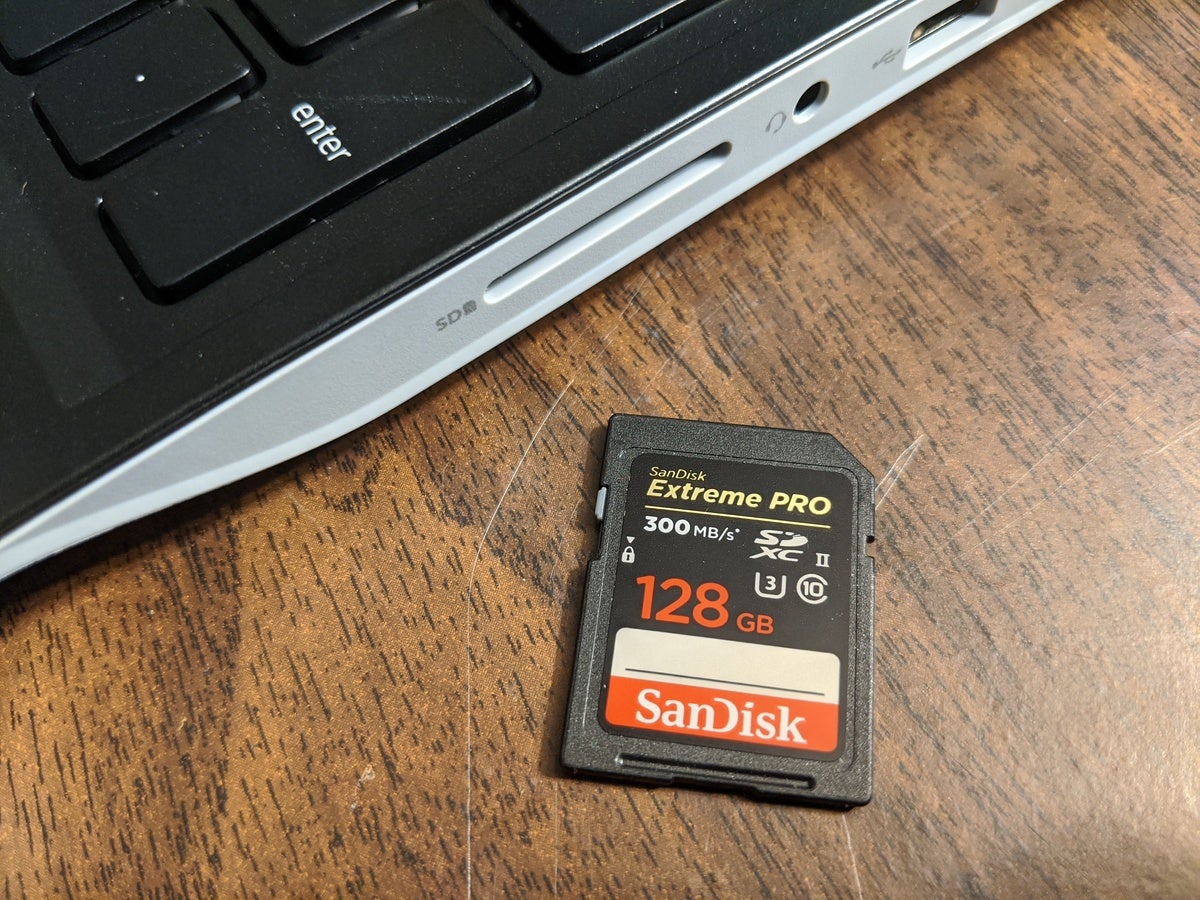 Gordon Mah Ung
Gordon Mah Ung We misused a 128GB SanDisk Extreme Pro card rated for 300MBps reads and 260MBps writes for our testing.
The SanDisk Extreme Pro SD Card is rated for interpret speeds right up to the restrict of UHS-II at 300MBps with write speeds rated at 260MBps.
Why not UHS-Trinity?
If you're curious why we're not victimization an equal faster SD card using the newer UHS-III bus, it's because we couldn't find out a card that even supported the newer interface, which takes speeds to 312MBps in full duplex mode and 624MBps in half duplex mode. Searching Amazon.com just last calendar week, we saw no signs of a UHS-III card for sale.
(And atomic number 102, Don River't confuse UHS-III (the bus) with the U3 symbol. U3 refers to the card's "UHS Speed Class" cross out for video execution of a camera and bill of fare. Yes, they seriously have U3 and UHS-III which don't mean the aforementioned thing. U3 has largely been supplanted by the newer and slightly less confusing "V" video speed class mark.)
We contacted SanDisk to ask why it wasn't offering a newer UHS-III bus card. Company officials aforementioned it's largely concentrating on the even faster South Dakota Verbalise standard, which has a speed limitation of 3,940MBps.
Laptop SD Card slot performance
All four laptops feature integrated card readers, simply performance varied greatly, equally you can see from our first try, Quartz Disc Mark's default successive read test. The Dingle XPS 15 9500 comes out in front by a fair allowance over the XPG Xenia 15 and Dell G5 15 SE, merely information technology's very about the Gigabyte Aero 17.
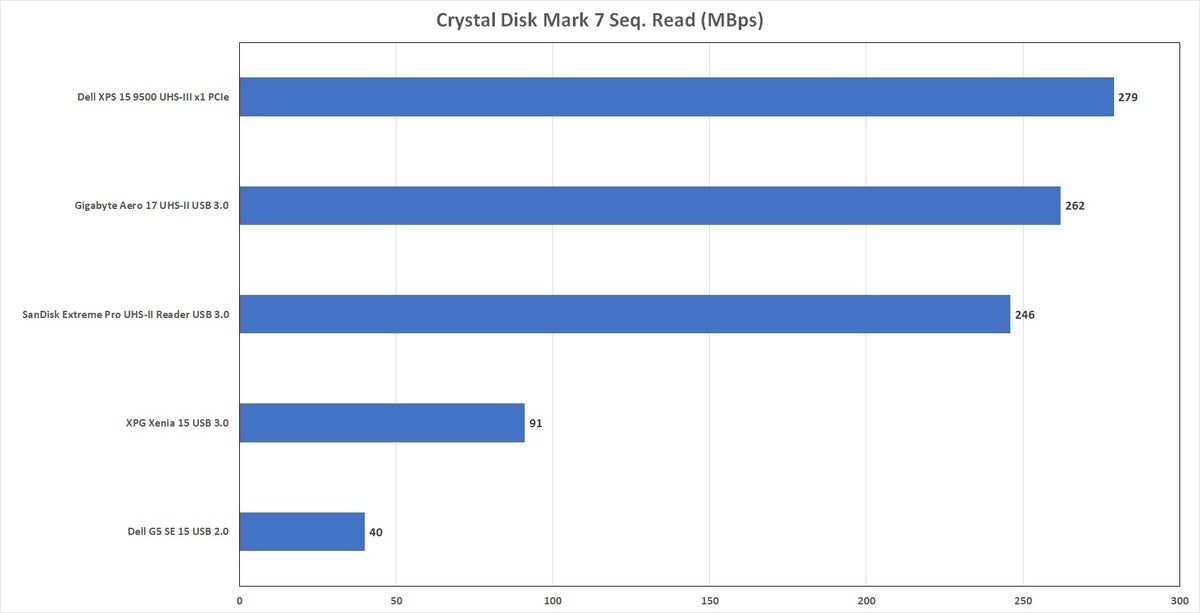 IDG
IDG Aero 17 and XPS 15 9500 users commode be happy they're getting awesome read performance, but you're likely wondering just why the Xenia 15 and G5 SE 15 are sucking wind. You'll fancy the reason out if you look at the labels for the laptops above: It's largely referable the card reader and the interface they're connected to.
For the worst laptop computer here, the Dell G5 15 SE, IT's likely gated by the USB 2.0 port it's strung-out up. USB 2.0 has a maximum speculative speed of 480Mbps or 60MBps. Once you account for overhead it's generally further lower than 60MBps.
After the Dell, the XPG Xenia 15 doubles the performance of the G5 15 SE with about 91MBps read speeds. The Xenia 15 highlights the other outcome that matters for a laptop computer's SD card reader: It's not just the interface, it's also what the host card reader is rated for.
For the Xenia 15, we couldn't detect anything other than that it's a RealTek card reader on USB 3.0. Because USB 3.0 can achieve speeds of 5Gbps or 625MBps on paper, we know it's not the USB 3.0 user interface. We backside alone assume that the Xenia 15 uses a UHS-I referee rated for 104MBps transport speeds.
We make that presumption because understandably the Aero 17 on USB 3.0 with its RealTek UHS-II reader can easily reach 262MBps read speeds. Our control, the SanDisk Extreme Pro UHS-Cardinal reader, also can hit a decent 246MBps understand speed.
The winner of this, although non by the margin you'd hope for, is the Dingle XPS 15 9500, with its UHS-III-rated RealTek card reader dependant up to the PCIe coach. The XPS 15 9500 has a decent edge, but it's likely gated by the fact that we only when have access to a UHS-Deuce calling card for our testing.
Laptop SD one-armed bandit write speeds
Writing to the cards is slower for the XPS 15 and Aero 17 and largely a tie. The SanDisk Extreme In favor card reader also does a fine job. Meantime, the G5 15 SE and Xenia 15 are far, far behind the pack.
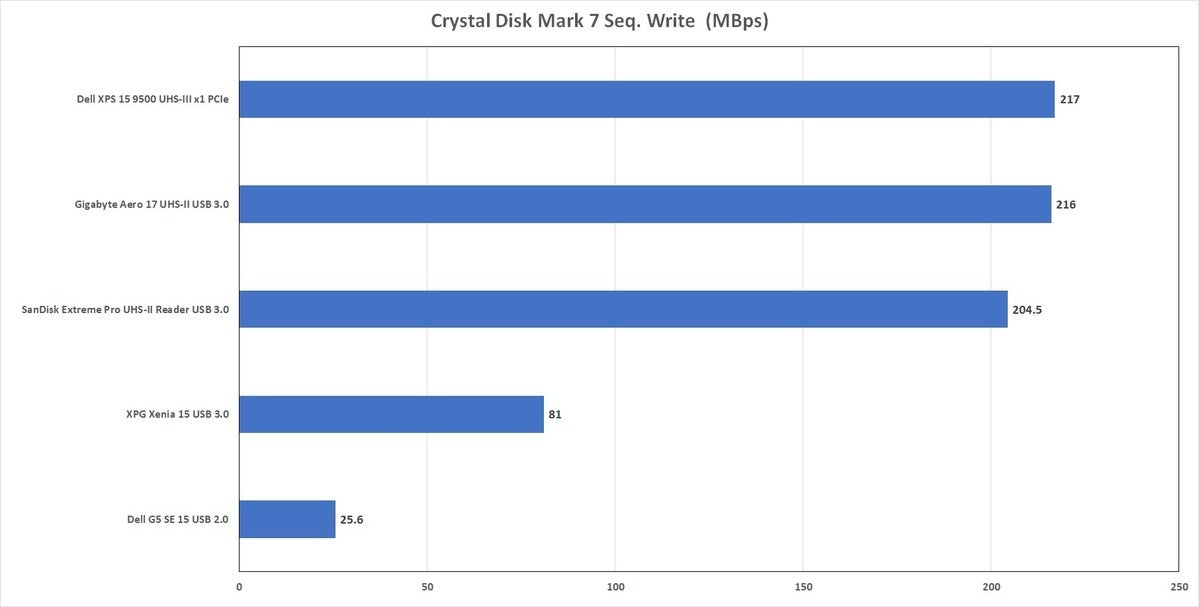 IDG
IDG Real-world tests
Written material to an South Dakota card from a laptop isn't something well-nig the great unwashe do. The most common method is to shoot photos or video to an SD card so copy the contents to your laptop for redaction in the field.
To simulate that we took a folder of 266 JPEG and RAW files totalling 3.4GB, shot with a Canon EOS 5D Fool IV. We manually timed how long-staple information technology took to copy the files to the Windows desktop of each laptop. We performed the test three multiplication, with reboots between runs to remove OS caching from equation. We likewise manually trimmed the laptop's internal SSDs in front testing was conducted.
The results largely mirror our read tests using Crystal Platter Mark 7. The higher-performance visiting card readers all dog very closely, the Xenia 15 achieves an accepted 47 seconds, and the G5 15 SE strolls past the finis line the next day.
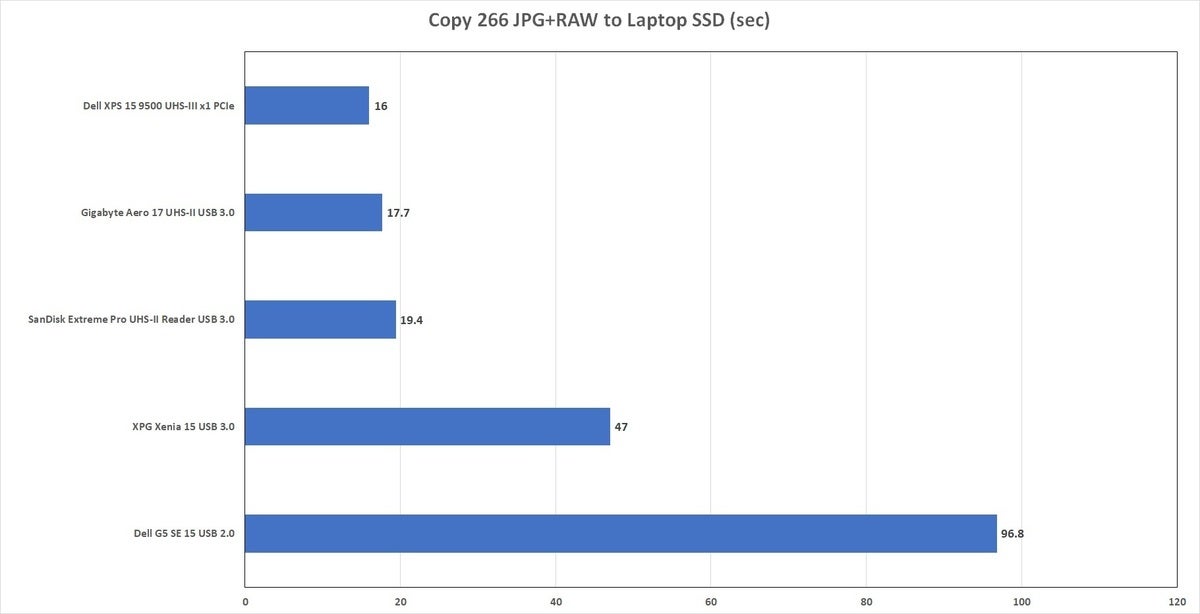 IDG
IDG Our last tryout created a nine-minute video with the Eos 5D Mk IV, using its 4K video setting. The camera uses the insanely inefficient MJPEG codec at a 500Mbps piece rate, which produced a big 34GB file. As with our still image test, we take an average of manually regular runs with reboots in between.
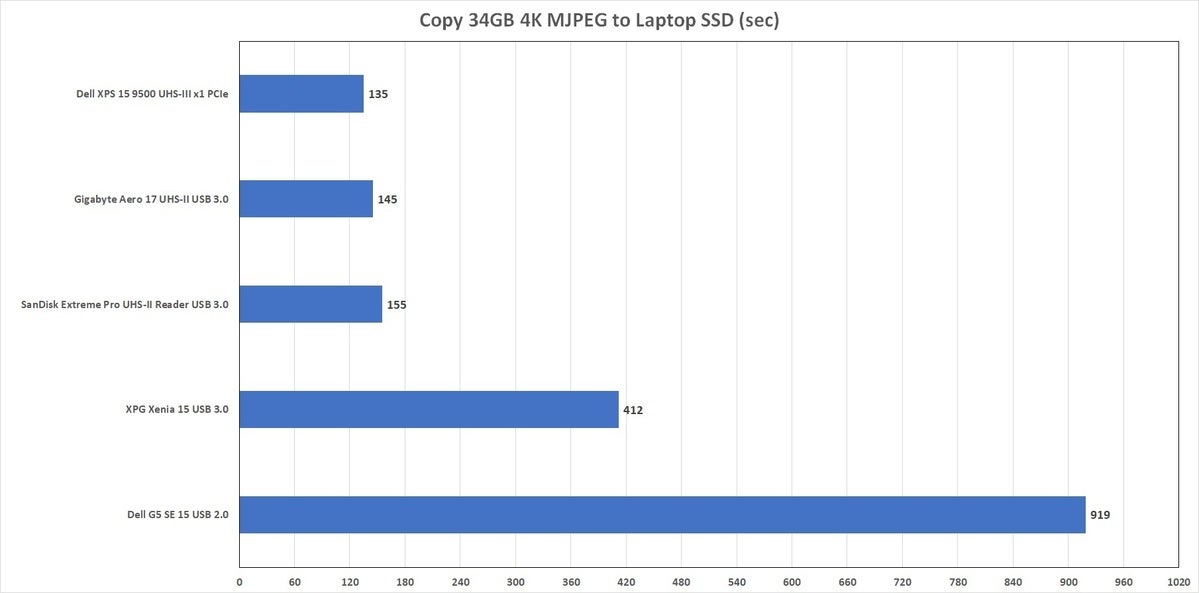 IDG
IDG With a file this tumid, we now see why having a high-speed SD card reader is so valuable. It takes a little over deuce minutes with the XPS 15 9500 and Aero 17 to copy a 34GB file in to the screen background. The Xenia 15 takes about five additional minutes to copy over. The Dell and its USB 2.0-restrain card reader takes a painful 15 minutes to do the comparable task. And call back: 34GB seems equivalent a large file, simply that means 90GB of video files would take probably 45 transactions. That's clip lost along the editing process.
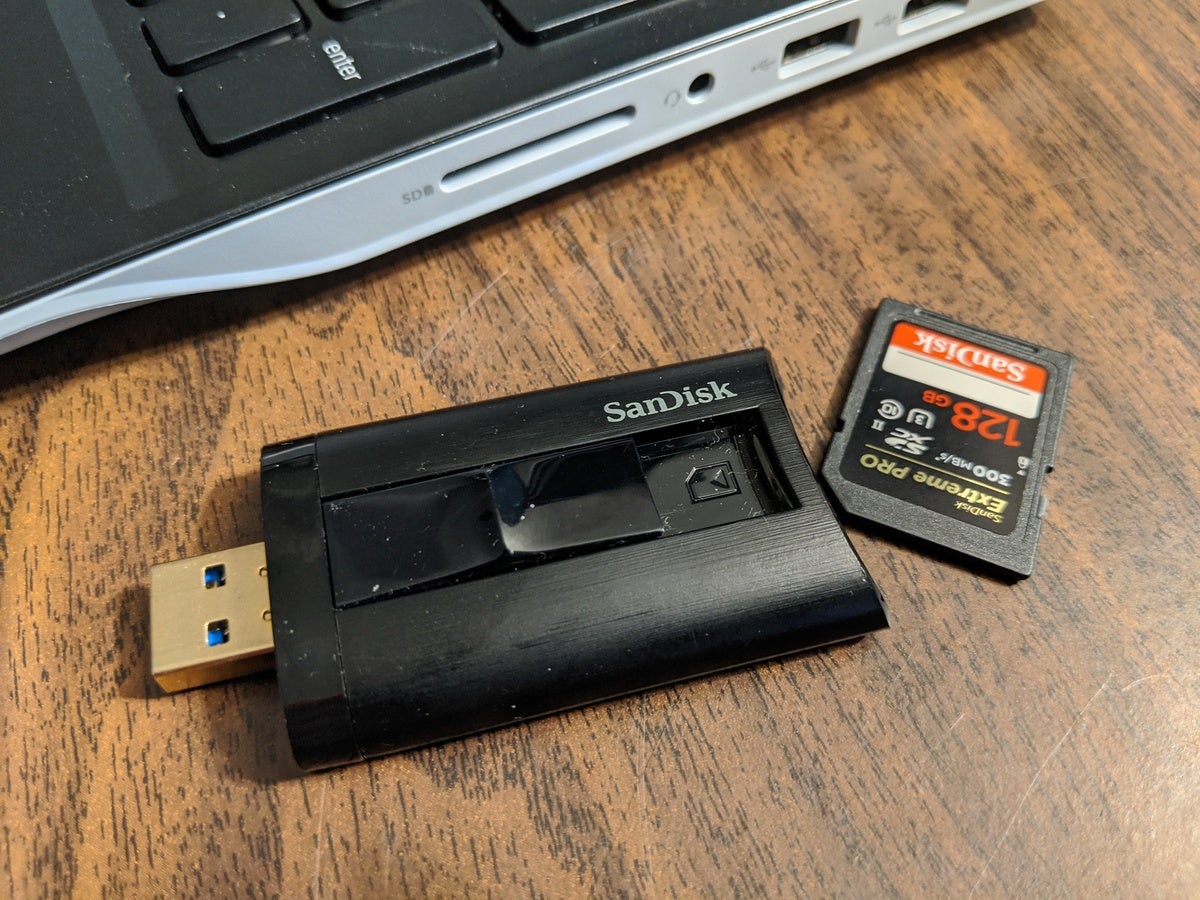 Gordon Mah Ung
Gordon Mah Ung Satisfied creators hate using external readers, just a allegro USB 3.0 subscriber such as this SanDisk Extreme In favor reviewer is probably faster than your laptop's reader.
Conclusion
The first takeaway from this is that clearly, not all laptop SD visiting card readers are created equal. All four of the laptops we tried are new models introduced this year, heretofore we see a big swing in performance.
The second takeaway is, stop turn up your nose at USB card readers. We've talked to content creators who check a lack of an onboard SD reader as a reason not to buy in a particular laptop. But you just don't know what raze of wit subscriber you're going to puzzle, even on red-hot laptops. Indeed just buy a verifiably good external reader and don't look back.
The one-third passport is not to get too involved in wanting UHS-Tierce. Some new laptops have touted UHS-III support As a bullet point, and to be fair, the Dell XPS 15 9500's UHS-III reader along the PCie 3.0 bus was systematically the fastest in our tests. It's just not clear that the standard will matter if card makers skip UHS-III cards for Coyote State Express.
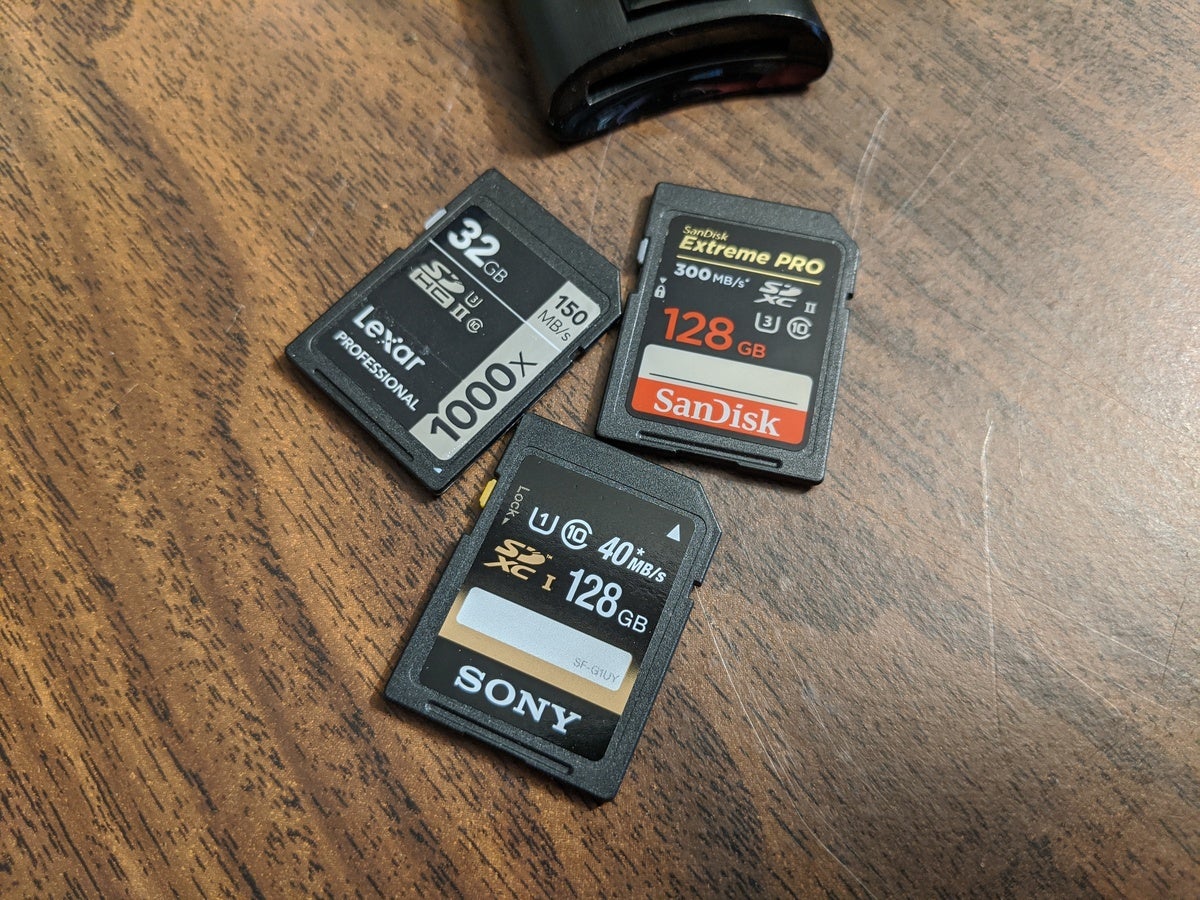 Gordon Mah Ung
Gordon Mah Ung The speed of your laptop's SD card won't matter if you only flow it slow 40MBps cards like the 128GB Sony UHS-I card below. Campaign a UHS-II card such as the 128GB SanDisk Extreme Favoring, which can hit 300MBps, Oregon even the Lexar plug-in which can orbit 150MBps.
Our final takeaway is this really matters only if you care about performance: to have a vivace SD card reviewer in your laptop, and eat information technology with a fast SD card. For instance, if you seem at the picture above, the 128GB Sony UHS-I posting will read at a dismal 45MBps and write at 36MBps connected the Dell XPS 15 9500. The Lexar UHS-II card will read at 153MBps and drop a line at 71MBps, while the SanDisk Extremum Favoring will read at 279MBps and write at 217MBps. Soh Don't feed a fast laptop a decelerate card, and Don't feed a dumb laptop a fast card, if you care about carrying into action.
Source: https://www.pcworld.com/article/393331/why-your-laptops-sd-card-reader-might-be-terrible.html
Posted by: edwardsgeoll1980.blogspot.com

0 Response to "Why your laptop’s SD card reader might be terrible - edwardsgeoll1980"
Post a Comment